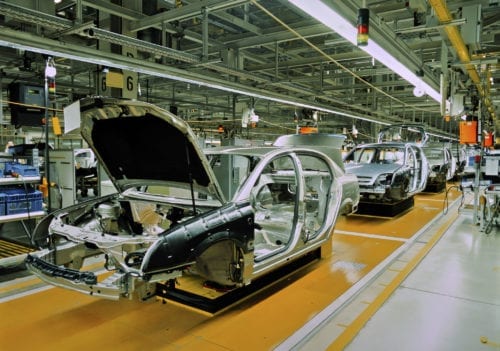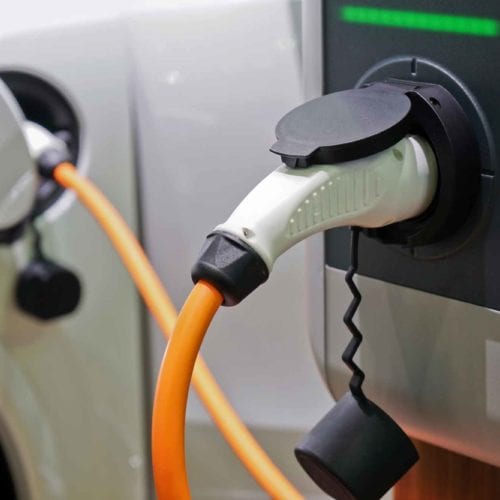unfinished automobiles in a car plant

1 in 5 Cars Need to Be Electric by 2030: What Will it Take?
Last month, GM President Mark Reuss wrote an op-ed titled, “Electric cars won’t go mainstream until we fix these problems.” Mark’s article summarizes the top reasons why EVs haven’t yet achieved widespread adoption: EVs struggle to compete with gasoline vehicles on cost and range, and there is not enough public EV charging infrastructure. Mark predicts that EVs with more efficient batteries will achieve cost parity with the internal combustion engine (ICE) vehicle within a decade, “maybe sooner,” and that widespread EV adoption will then be possible.
A decade ago, this would have been an exciting pronouncement. And the business-as-usual timeline of patiently waiting for consumer demand to grow, while battery efficiency and cost reductions are made, and more abundant EV charging infrastructure is put in place, would have been viewed by many as a pragmatic investment approach. But popular support is growing around the overwhelming scientific consensus that we’re in a climate scenario now that won’t wait for business as usual. And as this consensus gains more and more traction, all eyes will be on the light-duty vehicle sector.
Transportation is the single largest carbon-emitting sector in the United States, responsible for 29 percent of all emissions. And as electricity generation continues to rapidly transition to cleaner, renewable energy sources, transportation’s share of emissions is only growing. Within the transportation sector, light-duty vehicles in the United States account for 59 percent of emissions, 23 percent come from medium and heavy-duty trucks, and the majority of the remaining transportation emissions come from planes, ships, rail, buses, and motorcycles. Bottom line, there’s virtually no way to meet carbon reduction goals without a significant contribution from the light-duty vehicle sector.
An RMI review of key modeling results in literature reveals that even if the electric grid were on a path to achieve 75–85 percent of clean energy production by 2040, 15–20 percent of global light-duty vehicles would need to be electrified by 2030 in order to limit global temperature rise to less than 2°C and avoid the most catastrophic effects of climate change (and ensure that our cities are cleaner and more livable for billions of people around the world).
In the United States, this represents a staggering 40-50 million vehicles—and means that a seismic shift in how we power our vehicles and provide mobility services is necessary within the next ten years. According to evidence cited in RMI’s recent Seven Challenges for Energy Transformation report, “the difference between 1.5°C and 2.0°C of warming, although seemingly small, would be tremendously consequential.” To provide some temperature context, according to NASA’s Earth Observatory program, a 5°C drop in the global temperature was enough to “bury a large part of North America under a towering mass of ice 20,000 years ago.” That’s all it took.
Unfortunately, we are currently tracking toward a world with 3°–5°C of warming. Thus, our actions over the next 10 years, starting today, are more critical now than most of us thought. And today we are nowhere near the pace of EV adoption required to achieve this goal, raising the question, “What would it take for EVs to reach 20 percent of the vehicles on the road by 2030?” What Herculean efforts, policies, and incentives would be required? Can it even be done?
Shifting Demand
It’s clear that we must redouble all efforts to stimulate EV adoption across all car, bus, and truck segments. It’s also clear that policymakers and regulators are increasingly committed to achieving the carbon reduction goals. What automakers, bus-makers, truck-makers, electric utilities, and other key stakeholders need now more than ever is certainty in what lies ahead and what it will take to get there.
Of particular interest in Mark Reuss’ article was the mention of expected regulatory action against gasoline and diesel vehicles. If EVs on their own merits haven’t yet convinced consumers to make the switch, it is logical that if it were less convenient or more costly to own and operate an ICE vehicle, then consumers would be motivated to take a serious look at EVs.
All automakers have no doubt noticed the growing chorus of cities and countries around the world that have announced targets and timelines for the phaseout of diesel and then gasoline engines between 2025 and 2050. A ban of ICE vehicles would have been unthinkable just a few years ago—today, not so much. And there are other actions that could be taken—from feebates to gas-guzzler taxes and green zones in cities. Any of these policies would make it less appealing to own an ICE vehicle and very likely cause a shift in consumer buying behaviors. Automakers say they will build what consumers demand, so a demand shift is at the heart of a transition.
The question vehicle manufacturers need to answer is: What would you need from policymakers and regulators in order to deliver 40–50 million electric vehicles by 2030? What investments, incentives, or assurances do you need to withstand the “valley of death” that accompanies the introduction of EVs in the market until cost parity with a mainstream ICE vehicle can be reached? And what would it take to scale up the production of so many EVs? If policymakers and regulators are committed to the carbon reduction goals—what do you need them to do?
A Role for Everyone
Similarly, utilities (and their regulators) need to seriously engage beyond demonstration and pilot projects. Since 80 percent of all charging takes place at the home, the magnitude of the 2030 challenge would require that every utility offer well-promoted home charging programs that reach consumers living in homes as well as in townhomes, condominiums, and apartments.
And since 15 percent of charging takes place at work, utilities would also need to offer programs that reach every employer, both public and private. Workplace charging also provides an important alternative for consumers who don’t have a garage, driveway, or other convenient location to charge each evening. Once home and workplace charging programs are priorities, EV charging will feel much more ubiquitous to consumers. As for public charging, there is a need for more visible public charging—particularly fast-charging that will take us from city to city and fast-charging hubs in urban environments that can be shared by consumers, taxis, ride-sharing services, and even buses and delivery trucks. Again, if policymakers and regulators are committed to the carbon reduction goals—what do you need them to do?
And what do consumers need to do? One of the most important steps a consumer can take to reduce his or her carbon footprint is to replace an ICE vehicle with an EV. So with every vehicle purchase, consumers need to be asking: Is there an EV out there (new or used) that meets my daily driving needs and my pocket book? Or if not, am I prepared to cut back on a significant portion of the miles I drive each day? Because to meet the carbon reductions needed by 2030 will require both the electrification of the vehicles we drive and a reduction in the miles we travel.
So what’s it going to take? Support for aggressive investment in battery and vehicle plants, more incentives to lower the upfront price of EVs, regulations that bite into ICE vehicles, infrastructure that’s visible to all consumers? The window of opportunity to avoid the most severe consequences of climate change is closing quickly, and the challenge becomes more pressing with every year that passes. The business-as-usual approach to EV adoption won’t get us there.

